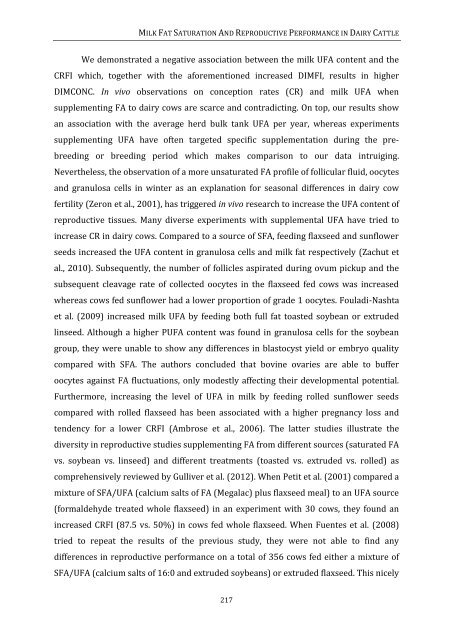view - Department of Reproduction, Obstetrics and Herd Health
view - Department of Reproduction, Obstetrics and Herd Health
view - Department of Reproduction, Obstetrics and Herd Health
You also want an ePaper? Increase the reach of your titles
YUMPU automatically turns print PDFs into web optimized ePapers that Google loves.
MILK FAT SATURATION AND REPRODUCTIVE PERFORMANCE IN DAIRY CATTLE<br />
We demonstrated a negative association between the milk UFA content <strong>and</strong> the<br />
CRFI which, together with the aforementioned increased DIMFI, results in higher<br />
DIMCONC. In vivo observations on conception rates (CR) <strong>and</strong> milk UFA when<br />
supplementing FA to dairy cows are scarce <strong>and</strong> contradicting. On top, our results show<br />
an association with the average herd bulk tank UFA per year, whereas experiments<br />
supplementing UFA have <strong>of</strong>ten targeted specific supplementation during the prebreeding<br />
or breeding period which makes comparison to our data intruiging.<br />
Nevertheless, the observation <strong>of</strong> a more unsaturated FA pr<strong>of</strong>ile <strong>of</strong> follicular fluid, oocytes<br />
<strong>and</strong> granulosa cells in winter as an explanation for seasonal differences in dairy cow<br />
fertility (Zeron et al., 2001), has triggered in vivo research to increase the UFA content <strong>of</strong><br />
reproductive tissues. Many diverse experiments with supplemental UFA have tried to<br />
increase CR in dairy cows. Compared to a source <strong>of</strong> SFA, feeding flaxseed <strong>and</strong> sunflower<br />
seeds increased the UFA content in granulosa cells <strong>and</strong> milk fat respectively (Zachut et<br />
al., 2010). Subsequently, the number <strong>of</strong> follicles aspirated during ovum pickup <strong>and</strong> the<br />
subsequent cleavage rate <strong>of</strong> collected oocytes in the flaxseed fed cows was increased<br />
whereas cows fed sunflower had a lower proportion <strong>of</strong> grade 1 oocytes. Fouladi-Nashta<br />
et al. (2009) increased milk UFA by feeding both full fat toasted soybean or extruded<br />
linseed. Although a higher PUFA content was found in granulosa cells for the soybean<br />
group, they were unable to show any differences in blastocyst yield or embryo quality<br />
compared with SFA. The authors concluded that bovine ovaries are able to buffer<br />
oocytes against FA fluctuations, only modestly affecting their developmental potential.<br />
Furthermore, increasing the level <strong>of</strong> UFA in milk by feeding rolled sunflower seeds<br />
compared with rolled flaxseed has been associated with a higher pregnancy loss <strong>and</strong><br />
tendency for a lower CRFI (Ambrose et al., 2006). The latter studies illustrate the<br />
diversity in reproductive studies supplementing FA from different sources (saturated FA<br />
vs. soybean vs. linseed) <strong>and</strong> different treatments (toasted vs. extruded vs. rolled) as<br />
comprehensively re<strong>view</strong>ed by Gulliver et al. (2012). When Petit et al. (2001) compared a<br />
mixture <strong>of</strong> SFA/UFA (calcium salts <strong>of</strong> FA (Megalac) plus flaxseed meal) to an UFA source<br />
(formaldehyde treated whole flaxseed) in an experiment with 30 cows, they found an<br />
increased CRFI (87.5 vs. 50%) in cows fed whole flaxseed. When Fuentes et al. (2008)<br />
tried to repeat the results <strong>of</strong> the previous study, they were not able to find any<br />
differences in reproductive performance on a total <strong>of</strong> 356 cows fed either a mixture <strong>of</strong><br />
SFA/UFA (calcium salts <strong>of</strong> 16:0 <strong>and</strong> extruded soybeans) or extruded flaxseed. This nicely<br />
217









